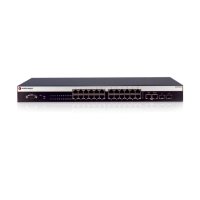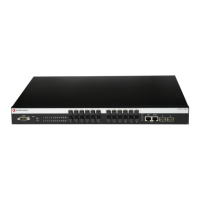Understanding How VLANs Operate
9-4 Configuring VLANs
• Shared Virtual Local Area Network (VLAN) Learning (SVL): Two or more VLANs are
grouped to share common source address information. This setting is useful for configuring
more complex VLAN traffic patterns, without forcing the switch to flood the unicast traffic in
each direction. This allows VLANs to share addressing information. It enables ports or
switches in different VLANs to communicate with each other (when their individual ports are
configured to allow this to occur). One FID is used by two or more VLANs. The FID value
defaults to the lowest VID in the filtering database.
See “Appendix F” of the IEEE Std 802.1Q™2011 standard for a detailed discussion of shared and
independent VLAN learning modes.
VLAN Assignment and Forwarding
Receiving Frames from VLAN Ports
By default, Enterasys switches run in 802.1Q operational mode, which means that every frame
received by the switch must belong to, or be assigned to, a VLAN. The type of frame under
consideration and the filter setting of the switch determines how it forwards VLAN frames. This
involves processing traffic as it enters (ingresses) and exits (egresses) the VLAN switch ports as
described below.
Untagged Frames
When, for example, the switch receives a frame from Port 1 and determines the frame does not
currently have a VLAN tag, but recognizes that Port 1 is a member of VLAN A, it will classify the
frame to VLAN A. In this fashion, all untagged frames entering a VLAN switch assume
membership in a VLAN.
The switch will now decide what to do with the frame, as described in “Forwarding Decisions” on
page 9-5.
Tagged Frames
When, for example, the switch receives a tagged frame from Port 4 and determines the frame is
tagged for VLAN C, it will classify it to that VLAN regardless of its port VLAN ID (PVID). This
frame may have already been through a VLAN aware switch, or originated from a station capable
of specifying a VLAN membership. If a switch receives a frame containing a tag, the switch will
classify the frame in regard to its tag rather than the PVID for its port, following the ingress
precedence rules listed below.
Ingress Precedence
VLAN assignment for received (ingress) frames is determined by the following precedence:
1. 802.1Q VLAN tag (tagged frames only).
2. Policy or Traffic Classification (which may overwrite the 802.1Q VLAN tag). For more
information, refer to “Configuring Protocol-Based VLAN Classification” on page 9-13.
3. Port VLAN ID (PVID).
Note: SVL is not supported on the stackable and standalone fixed switches.
Note: A VLAN ID is always assigned to a port. By default, it is the default VLAN (VLAN ID = 1).

